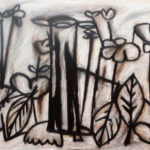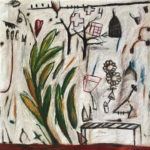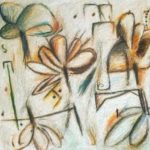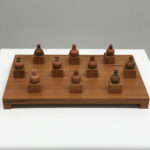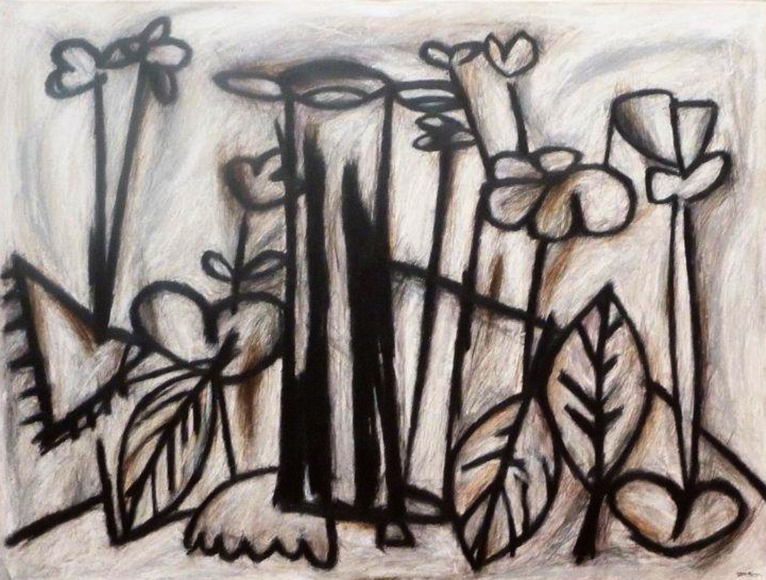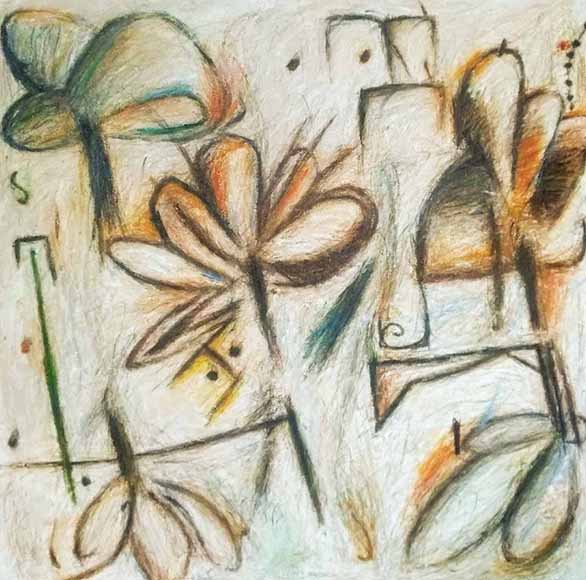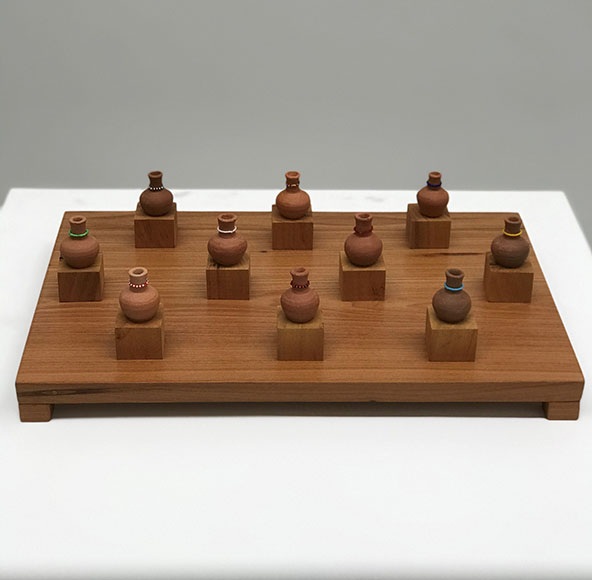Using forms of expression from the countryside of Bahia which fascinate him, such as the memory of drawings on walls of abandoned houses, his work refers to childhood curiosity, encompassing themes where sexuality, religion, culture, and social life become processes for a present which materializes in drawing, in painting, in objects and installations. It is a graphism which reveals, at first, a poetic of rediscovery of spaces, of reinvention of forms through the ways of approaching them, as a result of his research of materials, these replete with memories of the Recôncavo Baiano, where he has lived, by the artwork performed through the direct contact with the canvas, paper, wood, or the look inviting everyone to see the “things of the world” with “aggressiveness of being and occupying the immensity of dissatisfaction.”
Maxim Malhado was born in Ibicaraí, Bahia, in January 15, 1967. He lives in Massarandupió, Bahia. Having started exposing since 1995, was awarded seven times at the Salões Regionais da Bahia, and in 2001, received the Prêmio Aquisição Award at the 8th Salão do Museu de Arte Moderna da Bahia. He was selected at Itaú Cultural – Rumos Visuais 2001-2003, and in 2004 he has participated in the 26th Bienal Internacional de Arte de São Paulo. Among his expositions: Salão Nacional de Goiás; Salão Nacional de Arte do Pará; Salão Nacional de Curitiba, Paraná. His work can be found in several collections: Galeria ACBEU, Salvador, Bahia; Projeto Salvador Porto e Mar – Codeba; Centro Cultural Danneman, São Félix, Bahia; Instituto Cultural Brasil-Alemanha/ICBA, Salvador, Bahia; Museu de Arte Moderna da Bahia. He has recently participated in the Montevideo Biennial, Uruguay.
How do you identify the question of spatiality in your work, be it drawing, painting, objects or installations?
Like moving to a new house, like a “displacement”, like making cisterns to find water in the nothingness. These are among the questions of physics that appeal to me in the first place. The volume, the mass, the mass of objects, the question of occupying and vacating a space, my space and that of the other, and the silence that is in the environment — the emptiness that is and what is left — inside and outside. Secondly, I answer by recalling an exposition I made in 1994 in Sítio Novo, which I called“São João sem João, ai de mim sem João, sem Pedro e sem José, São João sem vocês, seu Flaviano, eu quero uma bomba de 0,50 e de quebra um bolinho pra velar meu espírito” (“Saint John without John, alas of me without John, without Peter and without Joseph, Saint John without you, Mr. Flaviano, I want a 0.50 bomb and a cupcake to veil my spirit”). The audience would enter the space in the dark, armed only with a lantern made with a can of milk, which would have to be shared with at least three other people. Inside there were drawings, objects, installations, all very graphic, perhaps it was my first contact with this matter of spatiality. Since then it has been transforming itself, especially according to the space. It also had something to do with religious and sexual issues which would be developed in the future.
Is this the main point of your work?
It is one of the most important points of my work: this gentle aggressiveness of being, occupying the immensity of dissatisfaction.
And within this discovery, how does the rhythm occur, the formal organization by its disposition, the harmony of the lines and objects, within this space of the artwork? This harmony is not born ready, I seek for something like the construction workers, the carpenters, the masters of works. Finding solutions for something you don’t have yet, turning things upside down, within a very real need. The forms are constructed for observation. Rhythm and harmony are given by insistence, by will and discipline, seeking a plumb line between lines and objects.
Is it a work that eminently proposes the discovery of space?
Yes, as if you were facing the world for the first time, as if you were going to learn how to draw, because it is not enough just to observe things, it takes much more than that. In some moments you really have to break free, without a guide, free from everything including the present. Only then, with time, the objects start creating curves, acquiring habits and customs, they discover ways within space.
Does the discovery of this space lead to a redefinition of meanings?
As I said, it depends on how we prostrate ourselves before the work, or where it is installed, depending on how we look at it, depending on the moment of the audience, what they bring as tools and references from the world, countless readings and meanings can begin to exist.
And in this rediscovered space, what do you bring as a reinvention of the forms and meanings that come to be your art, what do they carry from a memory that you bring from the countryside of Bahia?
I am very attracted to, for example, how the owners of wood-fired bakeries from the countryside of Bahia store their woods in front of their establishments, occupying the street, the parking lots, disturbing the passage of passersby there. I observe this kind of behavior and have been photographing it for years, and I was able to carry out part of this project in 2003 at the Instituto Cultural Brasil-Alemanha (ICBA-Salvador), under the title Amassando a Massa, where I have built a cube which represented a house, with a a single door, through which one could neither enter nor leave that space, in other words, a place completely interdicted with wood to the door. Right after, in 2003, I was able to hold a huge wooden mountain in an exhibition curated by Waldir Barreto and Agnaldo Farias, on the drawing in space. This format was probably the most popular. Before, I was able to build other art installations within the same research that would somehow refer to this universe and raise other questions about impediment, such as Mata-Burro, also held in Brasília. And in 2004, along with Ieda Oliveira, perform a show called precisely Impedimentos, where I presented a work called “Tá todo mundo desejando ser um animal, mas a maldade não deixa” (Everyone’s wanting to be an animal, but evil won’t let them) in which every member of the audience who came to the exhibition received a wooden pitchfork like those used on animals in order to prevent them from jumping the fence.
Is this condition of origin, the history of it, as it is translated in your art?
In 1995 I made a show in Sítio Novo, called Nas Canções do Rádio, where the audience, when entering the space, had the sensation of being in a cage, in a trap or even in a corral. Then I took this same exhibition to Feira de Santana, where I increased a little more the amount of my work, due to the size of the place. Then, at the entrance to the culture center, I built a passage through which, only through it, people should pass. It was like a corral, a fence. For this reason the director wanted to stop the installation. If it were not for the interference of the artist Juraci Dórea, I would not have being able to perform this work. These are the elements I somehow bring with my artwork to this day. Its origin, its history, what permeates its universe, especially the formal aspect, bringing from its source confrontations with contemporary issues.
Is this memory about the countryside your way of expression as the theme of your artwork?
Yes, that’s the starting point. It is my memory. I was born in the south of Bahia, was raised in Recôncavo Baiano and I bring all this with me. On the other hand, I do believe in non questions which answer themselves. They are getting visibility elsewhere as well. There’s a communication, a dialogue, an exchange of experiences with other worlds and expressions.
Is there a main theme in your photography? A religious, social, sexual or cultural theme?
Besides these, it also refers to the universe of construction, House construction, construction sites. My look at the technique used to remove the set square (with some pieces of wood in the ground, tied with nylon, surrounding the space, creating a wonderful drawing in the air), then comes the level (with only a plastic hose and water inside it) , to finally raise the walls, where the “plum line” enters. Are also elements I like to unfold and appropriate from.
But whatever the theme is, we see in your artwork an eminently graphic style. How do you relate to these definitions?
Sometimes when I had no stiletto knife, and at that time I really didn’t have access to one, I would use a razor or a pencil sharpening knife, and in the absence of any of those objects, I would actually use my teeth or the walls. From then on, my gaze was drawn to the black spots on the walls, the scratches, the holes made by nails, the charcoal drawings. At one point in my journey, I developed a research, paralleling what I called rural graphism versus urban graphism. Back in 1995, I attended my first exhibition, in Feira de Santana, held by Fundação Cultural do Estado. I presented three purely graphic designs, made with dry pastel, oil pastel and graphite, and there I was recognized for the first time, being awarded by the jury as a special highlight. So, whatever the theme or technique used to perform my work, this graphic style is always very strong.
There is also in your artwork a wood research, creating objects and an oil painting on canvas, and a paper painting that is glued to plates. Can you talk a little about some of those moments?
On the wood, for some time I have been developing work using this material, constructing objects, sculptures, installations. Since 2005, I have developed a series of objects that has a plumb line research as the development principle. Paintings on oil and acrylic canvas, as well as paintings on paper in mixed media, are mostly found in the construction universe, found within the house and its spaces, the equipment and objects that serve in its construction, and also in those objects that serve as “Decoration”, as well as utilities (kitchen cabinets, water filters, cupboards, drawers and corners). There are also other issues that can be seen in my paintings, like the sexual issue, especially in those with paper support.
In your objects and installations, I feel there is a demand for the physical experience of the audience, which is also a matter of space in your work. What do you think about this diffusion?
I certainly like to build objects, looking for a way in which somehow the object leaves the wall, which, in addition to occupying its space, it also invades the other, enabling the audience to resize themselves within that space, developing the look to “attention” and “warning” so that it somehow awakens the way they look to the things of the world.
How do you identify the starting point for the creative process of your art? What propels you? How does your working process work? What kind of stimulus triggers the creation of your artwork?
The work. As I said earlier, regarding discipline, the contact with those materials somehow allows me to open up an inner space, which in a way ease up the creative process. Persisting is the key to make things work. It’s not waiting. It is in the continuous work, it is in the certainty of the black on the white, and that’s precisely why even the “accidents” happen. If there’s no interaction, there won’t be a soul. It’s the certainty of will, before anything else, the stimulus arises from the necessity of the idea to become something. The work process happens by becoming intimate with things, things that calls to me, always regarding the same universe but filled with novelties and secrets, which again require care and study, to be then able to solve the best way for installing the artwork. At times I don’t need any of this. Other times, the work just happen. And sometimes, where there is no more need for it.
(interview/April, 2009)


